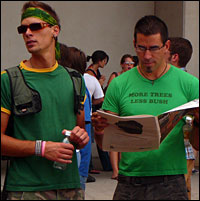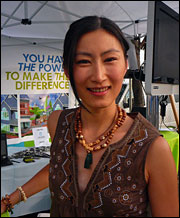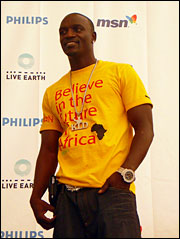Emily Gertz reports on environmental issues from her home base in Brooklyn, N.Y. She has written for Grist, BushGreenwatch, The Bear Deluxe, and other independent publications. She contributes to Worldchanging.com, and recently launched OneAtlantic.net: Environmental News & Views for the Atlantic Coast.

Saturday, 7 Jul 2007
EAST RUTHERFORD, N.J.
With Live Earth over, Al Gore, Kevin Wall, and their no-doubt-exhausted crew can be congratulated for pulling off at least one crazy ambitious feat: orchestrating a day of concerts across the time zones in eight cities on seven continents, with the cream of the global pop crop exhorting arena-sized crowds to be a lot nicer to the planet.

The giant stage at Giants Stadium.
Photos: Emily Gertz
But Gore and the rest of Live Earth’s organizers have made it clear that 07/07/07 had a bigger goal: to kick off a border-crossing movement, a sort of global polity of people linked by shared experiences, information networks, and a unified pledge to force political leaders to act against the worst of climate disruption.
Will they succeed?
I spent nearly 10 hot, humid hours at Live Earth New York City (held in New Jersey) trying to find an answer to that question.
I expected to be under-awed by sanctimonious rock stars and disgusted by fans buying their way to green heaven. But I came away more optimistic than I’d ever have thought. And about 25 years after I peaked as a Police fan, I finally got to hear them live. So rawk on!
Here are five things I took away from Live Earth*:
* Yes, I know it should be seven — 07/07/07, right. But this getting-paid-for-rock-journalism is a tough gig for an environmental writer. After all that sun and dancing, I’m exhausted. I’ll need a week just to regain my earnest demeanor and deathly pallor.

“More trees, less Bush” reads this buser’s T-shirt.
1. Hey, you really don’t have to own a car. Wanting to get into the climate-soothing vibe, I mass transited it out to Giants Stadium from New York City. OK, I always use mass transit, because I haven’t owned a car since 1988. But with hundreds of people converging on this event via one or more aging East Coast transit systems, I definitely feared the trip. However, the trains ran on time from Penn Station to Secaucus Junction, where Live Earth staff formed us into a long but organized line for the ample supply of free buses to the arena. Clearly some careful planning went into this, and it worked.
2. I’m an environmentalist, and that’s OK. As the line snaked around and around the station plaza toward the coaches, the conversations I overheard were a surprising mix of eco-critical and quotidian: a dude behind me was talking a friend’s ear off about Peter Singer, the controversial bio-ethicist who has taken radical stands on ending poverty, liberating animals, and stopping global warming. Then they started talking about stock trading. A young woman ahead of me was telling three gal pals how, since people changed their lives completely to win World War II, it was possible to do it to combat global warming — apparently something she’d heard Gore say in a recent interview. A few minutes later, her friend lamented losing her copy of the latest Rolling Stone on the way to New Jersey.

Yi Zhou of the Alliance for Climate Protection.
Once we got off the bus at the stadium, there was no deep-green messaging, just a modest array of enterprise-tinged activism. Youths sporting blue T-shirts printed with logos of both Live Earth and Pepsi, an Official Live Earth Partner, told concertgoers how to sort their garbage into the abundant bins. Cheery, sweaty staffers at the faux-barn booths of Stonyfield Farm (another Official Partner) handed out organic yogurt smoothies in biodegradable cups. A few concertgoers paused to sign up for wind power, or eye an adorable SMART Car, attracting camera crews desperate to capture people making some kind of earth-saving gesture. But most were intent on getting into the arena, and there was little planet-saving action to stop them.
An exception was the Alliance for Climate Protection booth, where concertgoers could buy eco- and fair-trade “protection bracelets” and sign the international seven-point pledge to solve the climate crisis — the Official Live Earth Activist Statement. (Once inside the stadium, concert-critters could text their pledges in as well, then watch for their names to scroll across a screen on stage.) The much-touted pledge is vague in some spots, such as a promise to reduce personal CO2 pollution “as much as I can.” But its first point is a strong political statement, demanding that within the next two years countries join an international treaty to cut climate-changing pollution by 90 percent in developed nations. This puts the call to action squarely where it can do the most the fastest — on world leaders — and strikes me as a welcome change from the “green is the new black” chorus encouraging us to shop our way to a better atmosphere.
3. Rock (and hip-hop and pop) ain’t dead. Much has already been said about the music itself, and there were indeed some incredible performances at Giants Stadium. Keith Urban and Alicia Keys made my skin tingle with their white-hot duet on “Gimme Shelter,” and Roger Waters delivered a “Dark Side of the Moon” for the ages. Two decades past their prime as a global phenomenon, The Police sounded more than a bit muddy during their show-closing set. But their music was a time machine to my tender youth, when I was a hopeful young activist, not a hard-bitten environmental reporter — so no complaints here. And really, what song besides “Message in a Bottle” could close a global rock show sending out an SOS for the planet?
Every one of the day’s eight shows is available at LiveEarth.org — underscoring Live Earth’s ambition to leverage 07/07/07 a lot further than the Live Aid/Farm Aid/Live Eight model of getting people to spend some money, hear some music, spin the good karma wheel, and walk away.
4. KT Tunstall insulates with sheep’s wool. While major broadcast outfits like the BBC, MSNBC, The National Geographic Channel, and even The Weather Channel got curtained booths and lots of places to plug in their gear inside the massive press tent, we lesser hacks got spaces at long tables with too few folding chairs and power strips, to peer at large video feeds of the show. Still, I had the same big green “media” credential around my neck they did, which got me into the day’s many, many press conferences: thrilling opportunities for reporters, bloggers, and photographers to take photos of the kings, queens, lords, and ladies of rock, pop, and hip-hop, and ask inane questions like, “What is your worst eco-sin?” or “Would you only date someone who’s green?”

Akon, new to the green scene.
Some musicians proved passionately articulate about the cause — like KT Tunstall, who described her biodiesel tour buses, the solar panels and sheep’s-wool insulation being installed at her home, and the 6,000 trees planted in Scotland “munching away” on her carbon footprint — then said all this was a stopgap until there’s strong global political action. “It can be really annoying when people like me have some success,” she said, “and then think they have something interesting to say.”
Asked how green he was, Senegalese-American hip-hopper Akon responded that he “didn’t know much about it before coming here today,” and then shifted the emphasis. “The environmental thing is a different situation in Africa,” he went on. “We’re just trying to clear up the poverty thing first.” And John Mayer, who wears his green heart on his sleeve, didn’t overestimate the value of a musician’s advice on climate disruption. “You think people want to listen to a hundred things you can do to change your house,” he snarked, “or a rock song?”
5. Butt shimmying is a form of activism. Wasteful, hypocritical, and naive were some of the kinder charges leveled against Live Earth in the days before — and after — the show. And there were the usual wheezes about the energy and fuel Live Earth used, and the amount of greenhouse-gas pollution no doubt generated getting tens of thousands of people to and from the eight venues. But I’d like to hear these same sour voices point out that all this underscores our needs for mass transit to get people out of their cars; strong fuel-efficiency standards to make those cars less polluting; massive and immediate funding to create a national clean-energy infrastructure; or action from citizens and shareholders to force government and corporate action.
According to Live Earth, the concerts “reached more than 10 million online,” and fans organized over 10,000 “Friends of Live Earth” events to coincide with the shows. I have no way to confirm that these numbers are correct, or what they’d mean if they were. But I can say that Live Earth was tons more fun than any political march I’ve ever attended, and has as much chance of being effective.
The SOS for the climate message seemed to mix seamlessly with the everyday actions of a typical arena rock crowd … and that’s great. Green needs to go from being the new black to being totally unremarkable — like changing a light bulb, buying a car, shimmying our butts at a show, and voting in the next election for a woman or man who’s committed to taking good care of the climate. With hope, Live Earth is a first step down that path.

